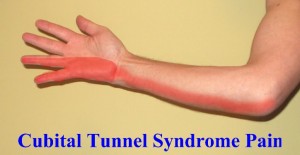回家路的博客
这一生,我们都在走在回家的路上!


The ulnar nerve passes underneath the medial epicondyle. Commonly referred to as the “funny bone,” the medial epicondyle is a bump on the inside part of the elbow. At this point, the ulnar nerve is located directly beside the bone making it especially prone to pressure.
When nerve tension and pressure becomes severe enough to disrupt normal nerve functioning, tingling, numbness, and pain may be experienced in the fingers, elbow, hand, and/or forearm. This condition is known as cubital tunnel syndrome.
Cubital Tunnel Syndrome Causes
Ulnar nerve pressure can develop for several reasons. As mentioned above, this nerve is located directly beside the bone. There are insufficient amounts of padding over top of the nerve to protect it. Hence, nerve pressure can easily occur.
Leaning the arm, on a table or other hard surface, and against the inner elbow all can cause it to “fall asleep”. This constant force on the ulnar nerve can cause pain. When this takes place over and over again, numbness, and/or pain can become more persistent and sustained.
Sometimes, the ulnar nerve will click backwards and forwards over the medial epicondyle (bump) as the elbow goes through the action of bending and straightening. If this happens repetitively, the ulnar nerve can become irritated significantly. Occasionally, connective tissue located over the ulnar nerve thickens or there is a muscular variation over the nerve leading to increased pressure on the ulnar nerve.
Additionally, long periods of holding the elbow in the same bent position can stretch the nerve across the funny bone. This kind of sustained elbow bending tends to happen while an individual is sleeping.
Cubital Tunnel Syndrome Signs and Symptoms
Cubital tunnel syndrome signs and symptoms often include numbness, pain, and tingling. Numbness and tingling typically develop within the ring finger or little finger. Generally, symptoms are noticeable when there is increased nerve pressure.
Examples of increased pressure include placing the elbow on the arm rest of a chair, repetitively bending/straightening the elbow, and sustained episodes of the elbow being held in a bent position (when sleeping or using a telephone for long periods).
Other signs and symptoms include noticeable weakness when pinching with the fingers and dropping held objects. In particularly severe cases, a total loss of feeling can be experienced and hand or wrist muscles will lose strength and bulk.
Cubital Tunnel Syndrome Surgical Treatment Options
Sometimes, cubital tunnel syndrome symptoms can be alleviated without surgical intervention, particularly if there is minimal nerve pressure. In addition, changing how the elbow is used can reduce the pressure that the ulnar nerve is subjected to.
In severe cases of cubital tunnel syndrome, or with those patients who do not see any significant improvement with non-invasive treatment methods, surgery may be necessary to relieve sustained nerve pressure. Approximately 85 percent of patients respond positively to surgical techniques which release ulnar nerve pressure. Orthopedic surgeons in Phoenix typically recommend one of three different procedures including:
- Simple Decompression: Shifting the ulnar nerve to a position just ahead of the elbow, alleviating the pressure and tension.
- Anterior Transposition: Moving the ulnar nerve underneath a fat layer, muscle, or within a muscle layer.
- Medial Epicondylectomy: Trimming the medial epicondyle. The ulnar nerve passes underneath this bump on the inner part of the elbow.
http://fxrxinc.com/blog/sports-medicine/surgical-treatments-of-cubital-tunnel-syndrome/




